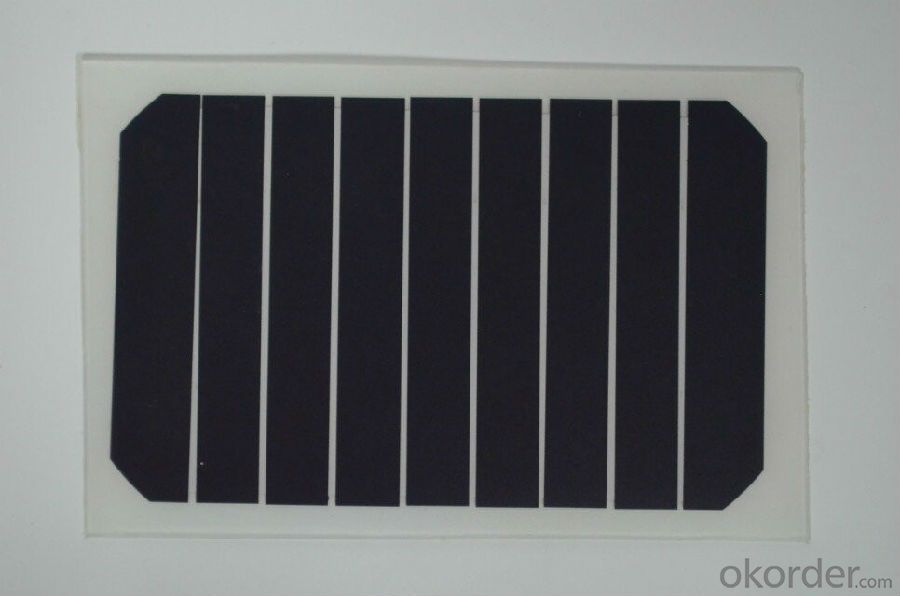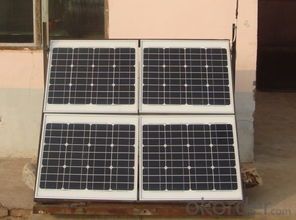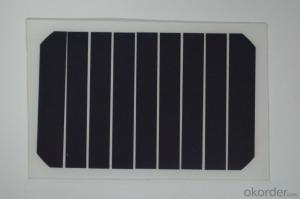High Quality 3W to 5W Monocrystalline Solar Panel CNBM
- Loading Port:
- Qingdao
- Payment Terms:
- TT OR LC
- Min Order Qty:
- 10 set
- Supply Capability:
- 300000 set/month
OKorder Service Pledge
OKorder Financial Service
You Might Also Like
3W to 185W Monocrystalline Solar Panel


Monocrystalline Solar Modules
We offers a range of small, medium and large monocrystalline solar modules, designed for a range of requirements.
Specifications:
Tolerance | +/- 3% |
Cell | Monocrystalline silicon solar cells |
N0. of Cells | 72 (12 x 6) |
Dimension of Modules (mm) | 1581 x 809 x 40 |
Weight (kg) | 15.5 |
Limits:
Operating Temperature | -40~+85? |
Storage Temperature | -40~+85? |
Maximum System Voltage | 1000 VDC max. |
Hail Impact | Diameter of 28mm with impact speed of 86km/h |
Temperature and Coefficients:
NOCT | 48C+/-2? |
Voltage temperature coefficient (%/K) | -0.34 |
Current temperature coefficient (%/K) | 0.09 |
Power temperature coefficient (%/K) | -0.37 |
Characteristics:
Model: | SGM-160D | SGM-165D | SGM-170D |
Max-power voltage Vmp (V) | 34.5 | 35.4 | 35.8 |
Max-power current Imp (A) | 4.64 | 4.66 | 4.75 |
Open-circuit voltage Voc (V) | 41.75 | 43.6 | 43.32 |
Short-Circuit Current Isc (A) | 5.32 | 5.08 | 5.38 |
Max-power Pm(W) | 160 | 165 | 170 |
Model: | SGM-175D | SGM-180D | SGM-185D |
Max-power voltage Vmp (V) | 36.1 | 36.2 | 36.2 |
Max-power current Imp (A) | 4.85 | 4.97 | 5.11 |
Open-circuit voltage Voc (V) | 43.68 | 43.8 | 44.8 |
Short-Circuit Current Isc (A) | 5.49 | 5.48 | 5.51 |
Max-power Pm(W) | 175 | 180 | 185 |
STC: Irradiance 1000W/m2, Module temperature 25?, AM=1.5
Monocrystalline Solar Panels Specifications Range
Maximum Power (Pm) | Dimension | Weight | Operating Voltage (Vmp) | Operating Current (Imp) | Open Circuit Voltage (Voc) | Short Circuit Current (Isc) |
3W | 158x241x25mm | 0.5kg | 8.5V | 0.36A | 10.5V | 0.4A |
4W | 308x166x25mm | 0.77kg | 8.5V | 0.47A | 10.5V | 0.54A |
4W | 308.x166x25mm | 0.77kg | 16.8V | 0.24A | 21V | 0.27A |
5W | 296x215x25mm | 0.3kg | 16.8V | 0.48a | 21V | 0.54A |
10W | 286x406x25mm | 1.5kg | 16.8V | 0.59A | 21V | 0.66A |
12W | 286x406x25mm | 1.5kg | 16.8V | 0.71A | 21V | 0.8A |
14W | 286x541x25mm | 2kg | 16.8V | 0.83A | 21V | 0.96A |
16W | 286x541x25mm | 2kg | 17.2V | 0.93A | 21.5V | 0.99A |
18W | 296x541x25mm | 2.4kg | 18.8V | 1.07A | 21V | 1.2A |
20W | 296x641x25mm | 2.4kg | 17.2V | 1.15A | 21.5V | 1.24A |
24W | 541x451x25mm | 3.15kg | 16.8V | 1.14A | 21V | 1.56A |
26W | 541x451x25mm | 3.15kg | 17.2V | 1.51A | 21.5V | 1.63A |
30W | 296x966x25mm | 3.85kg | 16.8V | 1.78A | 21V | 2.03A |
36W | 541x641x35mm | 4.7kg | 16.8V | 2.14a | 21V | 2.4A |
40W | 541x641x35mm | 4.7kg | 17.2V | 2.33A | 21.5V | 2.5A |
55W | 1057x457x35mm | 6.6kg | 17.6V | 3.12A | 21.6V | 3.3A |
70W | 546x1196x35mm | 8.5kg | 16.8V | 4.15A | 21V | 4.7A |
75W | 546x1196x35mm | 8.5kg | 17.2V | 4.36A | 21.5V | 4.8A |
80W | 546x1196x35mm | 8.5kg | 17.6V | 4.55A | 21.6V | 4.9A |
110W | 1066x811x40mm | 11.8kg | 17.6V | 6.25A | 21.6V | 6.6A |
150W | 1066x811x40mm | 14kg | 34.4V | 4.36A | 43.2V | 4.7A |
- Q:How much money can you save by using solar panels?
- The amount of money you can save by using solar panels depends on various factors such as your energy consumption, the size of your solar panel system, and the cost of electricity in your area. On average, homeowners can save anywhere from 40% to 70% on their electricity bills by switching to solar panels. However, it's important to consult with a solar energy professional to get an accurate estimate based on your specific circumstances.
- Q:Can solar panels be installed on a residential community?
- Yes, solar panels can be installed on a residential community. Many residential communities are adopting solar energy as a sustainable and cost-effective alternative to traditional electricity sources. Installing solar panels in residential communities can help reduce energy costs, decrease reliance on fossil fuels, and contribute to a cleaner and more sustainable environment.
- Q:Can solar panels be used in cold climates?
- Yes, solar panels can be used in cold climates. While the efficiency of solar panels may slightly decrease in colder temperatures, they can still generate electricity even in freezing conditions. In fact, solar panels can even benefit from the reflection of sunlight off snow, which can increase their output. Additionally, advancements in technology and the use of anti-reflective coatings have improved the performance of solar panels in cold climates.
- Q:Can solar panels be installed on carports or other structures?
- Yes, solar panels can be installed on carports or other structures. In fact, carports and other structures can provide ideal locations for solar panel installation as they offer a suitable space to mount panels and can provide shade and protection for vehicles or other objects underneath. This allows for dual functionality and maximizes the use of available space for generating renewable energy.
- Q:Can solar panels be installed on asphalt shingles?
- Yes, solar panels can be installed on asphalt shingles. However, it is important to ensure that the shingles are in good condition and can support the weight of the panels. Proper installation techniques and mounting systems designed for asphalt shingles should be used to prevent any damage to the roof.
- Q:Can solar panels be installed on a metal roof?
- Yes, solar panels can be installed on a metal roof. In fact, metal roofs are often considered ideal for solar panel installation due to their durability and longevity. The metal roof provides a strong and stable surface for mounting the panels, and the sleek design of the panels can complement the aesthetics of the roof. Additionally, the metal roof's reflective surface can help enhance the overall efficiency of the solar panels by bouncing sunlight back onto them.
- Q:Do solar panels require direct sunlight to work?
- No, solar panels can still generate electricity even in indirect or diffused sunlight.
- Q:Can solar panels be installed on parking lots?
- Yes, solar panels can be installed on parking lots. In fact, many parking lots around the world are being equipped with solar panels to generate clean and renewable energy. These solar panels are typically installed on canopies or carports above the parking spaces, providing shade for vehicles while harnessing sunlight to produce electricity. This innovative solution helps to reduce carbon emissions and provides a dual benefit of generating power while maximizing the use of available space.
- Q:How much solar energy does a 2m by a 3m solar panel convert to energy on a sunny day? Assume that the solar cells are 30% efficient.I'm not looking for the answer so much as I need an explanation o how to solve this type of problem... Thanks!!
- You have the area of the solar panel. You know their efficiency. What you need to know now is the energy (per area) delivered by the sun. The energy delivered by the sun can be found on the internet. Earth ,43 – ,32 W/m? (wikipedia) That is offcourse for your solar panels perpendicular to the ray's of the sun. If they are under an angle you should see what the area of the projecton of your solar panel is on a plane perpendicular to the ray's of the sun. So know you have the intensity W/m? and an area (or effective area). Here you go the energy deliverd by the sun. And 30% of it is what you get out of your panels.
- Q:I have an inverter and a battery 20 Amperes.Daily sun shine approx. 7 Hours.Do I need to buy anything or should I connect the solar panel to the Battery direct?
- No, don't connect the panel directly to the battery. You need to isolate the solar panel charging output from the AC-powered charger. A couple of high-current diodes arranged with their anodes connected to the charging sources in the positive supply line will allow either the charger or the solar panel to lift the voltage high enough to charge the battery, albeit with about 0.6 volts dropped across the diode. Both cathode ends would be connected to the battery. This arrangement allows a positive current to flow from either or both charging sources at the same time, although in practice, one will generally be higher than the other. Also, if the AC charger's voltage is significantly higher than the solar panel, the charger may always charge the battery. You would need to regulate its output to be slightly lower than the solar panel when it's near it's minimum useful operating voltage. (note that the 0.6 forward bias voltage on the diode might prevent the solar panel from completely charging the battery if it has any voltage regulation on its output)
1. Manufacturer Overview |
|
|---|---|
| Location | |
| Year Established | |
| Annual Output Value | |
| Main Markets | |
| Company Certifications | |
2. Manufacturer Certificates |
|
|---|---|
| a) Certification Name | |
| Range | |
| Reference | |
| Validity Period | |
3. Manufacturer Capability |
|
|---|---|
| a)Trade Capacity | |
| Nearest Port | |
| Export Percentage | |
| No.of Employees in Trade Department | |
| Language Spoken: | |
| b)Factory Information | |
| Factory Size: | |
| No. of Production Lines | |
| Contract Manufacturing | |
| Product Price Range | |
Send your message to us
High Quality 3W to 5W Monocrystalline Solar Panel CNBM
- Loading Port:
- Qingdao
- Payment Terms:
- TT OR LC
- Min Order Qty:
- 10 set
- Supply Capability:
- 300000 set/month
OKorder Service Pledge
OKorder Financial Service
Similar products
New products
Hot products
Related keywords




























